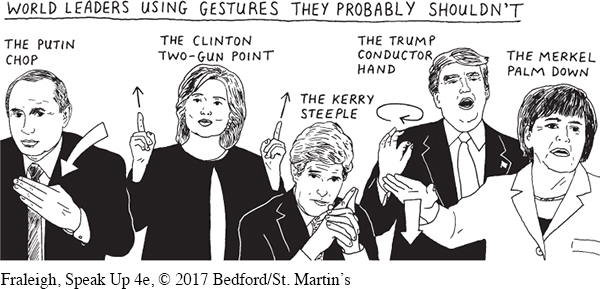Gestures
A gesture is a hand, head, or face movement that emphasizes, pantomimes, demonstrates, or calls attention to something.4 Gestures can add flair to your speech delivery, especially when they seem natural rather than overly practiced.5 Research also indicates that gestures can benefit a listener’s ability to understand a speech’s message.6 The effectiveness of a gesture depends on how it links with the speech topic—
Page 389

But gestures can backfire. For one thing, not all your listeners will interpret the same gesture—
You also should be aware that gestures may communicate a message that is inconsistent with your verbal message. For example, some people have criticized President Obama when he points an index finger straight up and wags it back and forth when speaking. This gesture can work if the intention is to criticize or dismiss an individual or a group, but it risks making the speaker seem arrogant, overly pious, or condescending. Gestures like this also can reinforce negative perceptions that a particular audience may already have. For example, many of the president’s critics in Congress felt that he was book smart but not experienced in the political realities of Washington, DC, because he had served in the U.S. Senate for only four years before being elected president. For them, the president’s wagging finger may have reinforced the image of a professor lecturing them as if they were his students and not his political peers.
Page 390
To see an example of artificial-
In addition to ensuring that your gestures reinforce your spoken message, avoid using distracting gestures born of nervousness—
To get the most from gestures, follow these guidelines:
Use gestures deliberately to emphasize or illustrate points in your speech.
Remain aware that not all audience members may interpret your gestures in the same way.
Make sure your gestures reinforce your spoken message.
Avoid nervous, distracting gestures.
